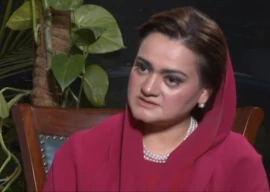
The discourse on language, culture, arts and architecture continued on the second day of the Trust for History, Art and Architecture, Pakistan’s (THAAP) conference.
The papers presented on Saturday reviewed Mughal miniature art, the evolution of courtyards, architectural transformations in the Punjab, the loss of Punjabi language and the sacred roots of Punjabi culture.
Participants came from the Lahore University of Management Sciences, Kinnaird College for Women, Indus Valley School of Art, the University of Engineering and Technology Lahore, Punjab University, the University of Gujrat, the Beaconhouse National University and the National College of Arts.
Aqsa Yasin and Bazla Manzoor of Bazal Associates presented a paper titled Evolution of Courtyards in Central Punjab – Pakistan. Their study focused on Sardar Saheb Haveli, near Chiniot. Yasin, a young engineer, and Manzoor, an architect, spoke about the architecture of central Punjab and the functional features of courtyards. Yasin said the architectural concepts of the province were not limited to it. The region had adopted several concepts introduced by its invaders, she said.
Many architectural concepts in central Punjab, which includes Jhang, Faisalabad, Khanewal, Sargodha and Toba Tek Singh, are unique, she said, but are not completely detached from architecture in the rest of the province.
Courtyards of structures in central Punjab offered their residents open spaces within the building, as well as natural ventilation, said Manzoor. “But their greatest use was to provide privacy for household women,” she said. In view of cultural and religious norms of the region, the courtyards offered women an open air venue where their privacy would not be compromised.

Discussing the architectural features of Sardar Saheb Haveli, Manzoor said the courtyard constituted almost 33 per cent of the building’s area.
Osama Ahmad, an undergraduate student and research associate at LUMS, presented his paper on Punjab’s Architectural Transformations. The paper covered Indo-Greek classicism to British Colonial neo-classicism era. Ahmad spoke about the famous Montgomery and the Lawrence Halls in Lahore. The two structures, he said, now called the Quaid-i-Azam library, were initially used to host state events and balls. The two halls were constructed by G Stone in the late 1800s. The grand structures intended to reflect the grandeur of the Raj.
“Expressions of Mughal art have gone beyond the canvas,” said Abdullah Qureshi, artist and curator of the 39-K Art Gallery. His paper titled The Space of the Mughal Miniature focused on the shifting boundaries of paintings in the region. Qureshi said the boundaries had expanded physically and conceptually. Artists did not confine their expression to paint and canvass but took on various media. “It has transcended its physical space with artists now using sounds and their bodies to recreate the Mughal space,” he said. “Kathak dance and classical music had been used for that purpose.”
Dr Tariq Rehman’s paper How Punjab lost its Punjabi received loud applause. Rehman said while Punjabi was still a language of business, it had failed to receive political grounding. “It could be because Punjab lost much of its territory to India,” he said.
Responding to a query, Dr Rehman said Punjabi would have to be taught in schools and used on a large scale for any progress in this regard. “When children are schooled in a certain language it helps generate greater understanding and awareness of the language,” he said, “but this must be practised across the board, especially in elite schools.”
Pakistan’s culture was not that different from other postcolonial cultures in that it lay at an uneasy cross-section of two cultural currents - modern and traditional, said architect Taimoor Khan Mumtaz who read a paper on The Sacred Roots of Culture in Punjab.
Khan, an architect at the Kamil Khan Mumtaz Architects, said every individual had multiple identities based on different markers including language, religion, geography and ethnicity.
Published in The Express Tribune, December 8th, 2013.

1725366721-0/kyle-(1)1725366721-0-165x106.webp)
1731410017-0/BeFunky-collage-(45)1731410017-0-165x106.webp)

1732520496-0/BeFunky-collage-(86)1732520496-0-165x106.webp)





1732012115-0/Untitled-design-(14)1732012115-0-270x192.webp)






COMMENTS
Comments are moderated and generally will be posted if they are on-topic and not abusive.
For more information, please see our Comments FAQ